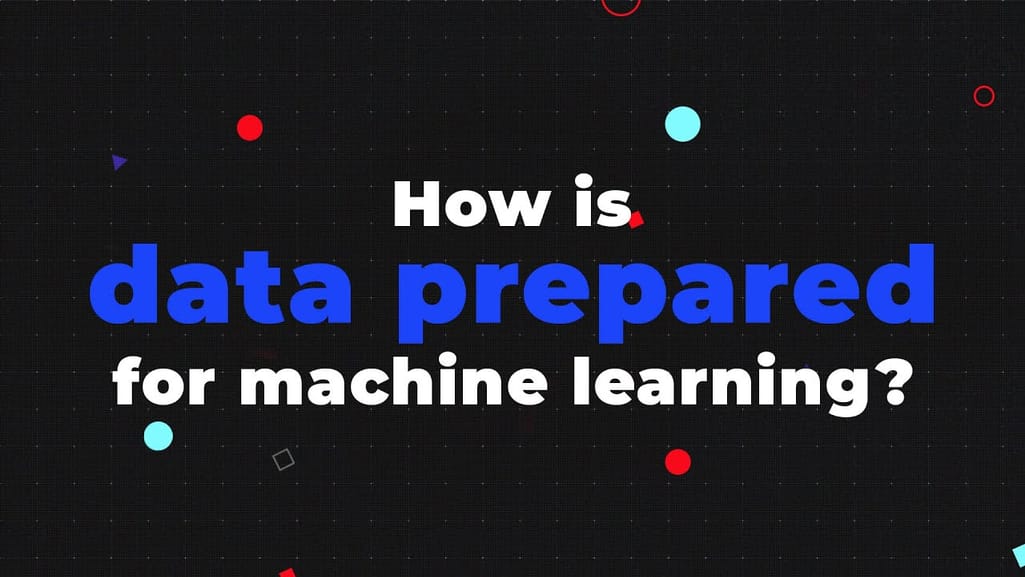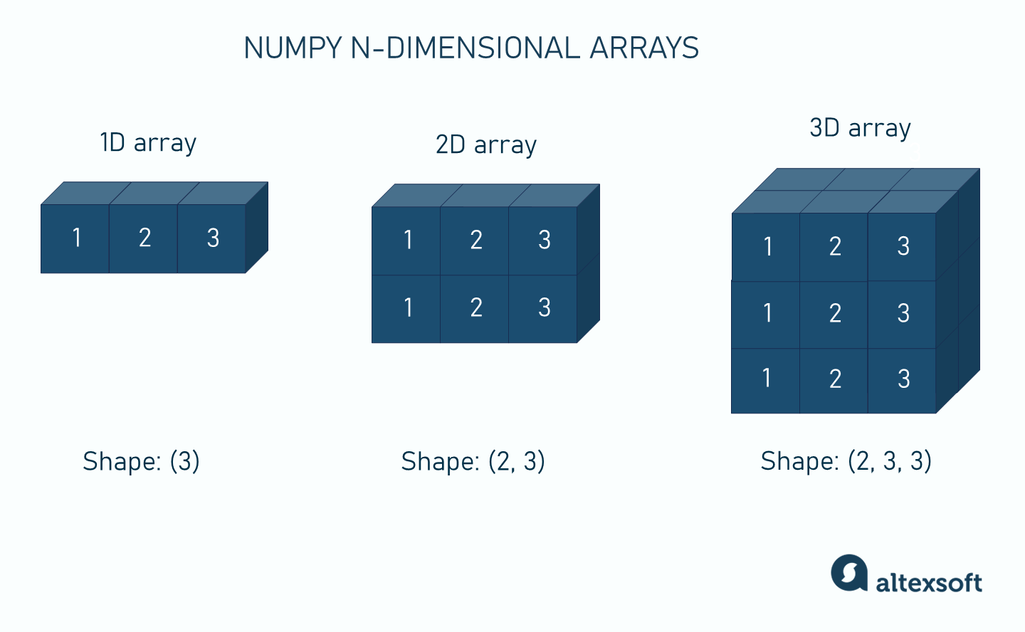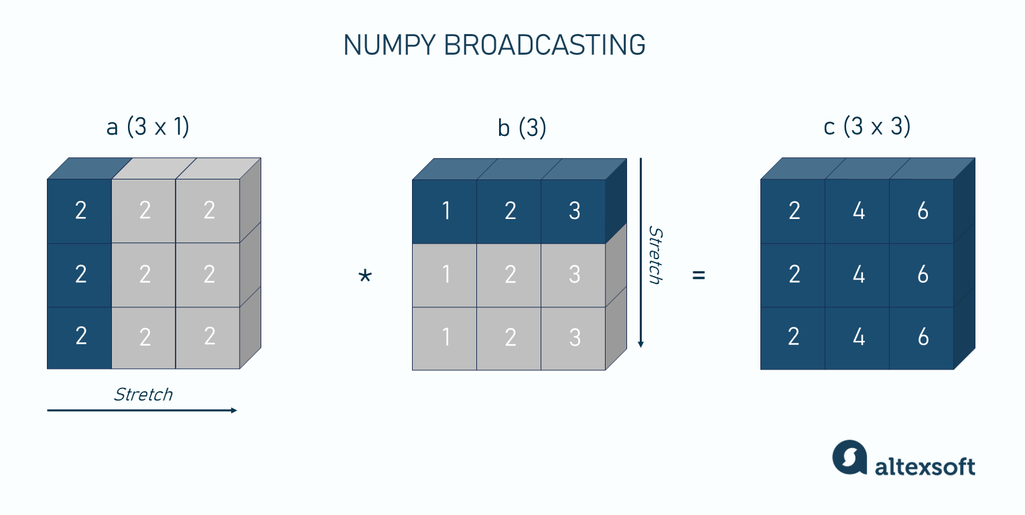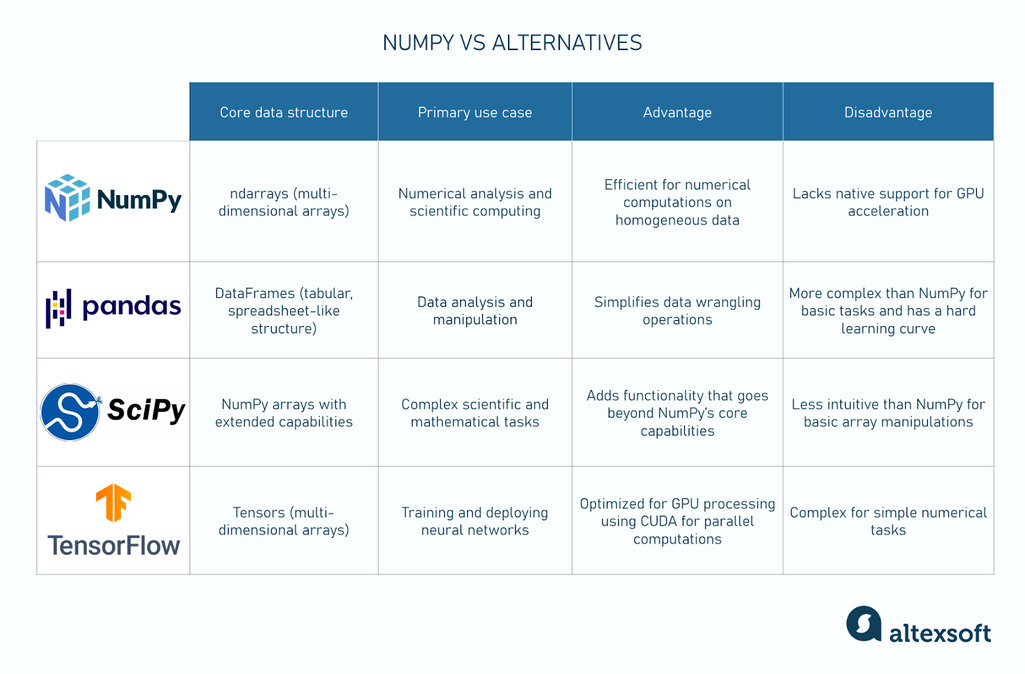It's widely accepted that data is the new oil. Businesses, academic bodies, and others are leveraging machine learning, data science, scientific computing, and other data-related processes to understand data properly.
One popular tool for powering data-related tasks is NumPy, a mathematical Python library. In this article, we will learn its core concepts, applications, pros and cons, and how it compares against counterparts like Pandas and SciPy.
What is NumPy?
NumPy, short for Numerical Python, is an open-source Python library for working with large, multi-dimensional arrays and matrices. Developed in the early 2000s from Numeric and Numarray, now deprecated array packages, it serves as the foundation for other Python libraries like SciPy, Pandas, and TensorFlow.
What is NumPy used for?
NumPy’s ability to perform complex mathematical operations on large datasets makes it an essential tool across fields that rely on extensive numerical calculations.
Scientific computing. NumPy finds applications in physics, biology, finance, engineering, and other disciplines. It’s highly effective for modeling and simulations of real-life systems.
Data preparation and analysis. You can use NumPy for different steps of data preparation and analysis, including data cleaning, transformation, aggregation, and more.


Data science, machine learning, and AI. NumPy supports linear algebra, which deals with vectors and matrices and serves as the backbone for machine learning, data science, and AI. Powerful large language models (LLMs) like ChatGPT are literally built on matrices. The library simplifies and speeds up matrix operations, which play a crucial role in data transformation, applying weights to features, calculating predictions, word embeddings to enable natural language processing (NLP), and other processes related to ML and AI.
Learn more about machine learning in our dedicated article.
Image processing. Images can be represented as multi-dimensional arrays, making NumPy particularly suitable for image processing tasks.
To better understand how NumPy works and why it’s so efficient for numerical tasks, let’s briefly explore its fundamentals.
Numpy arrays and operations on them
NumPy's n-dimensional array, or ndarray, is the library's most fundamental data structure, which is:
- multi-dimensional: you can create arrays with three, four, or more dimensions, which are called axes in NumPy;
- homogenous: they contain elements of the same data type (strings, integer numbers, real numbers, complex numbers, booleans, and some extra types not supported in regular Python); and
- have the shape property: it represents a number of elements in each dimension.

NumPy n-dimensional arrays
Numpy array consists of two blocks: the data buffer with data elements and the metadata with information about the data buffer, such as size and type of elements, number and size of dimensions, and more. The metadata helps manipulate arrays more effectively, streamlining core operations which include the following.
Indexing and slicing. Like other Python containers (lists, tuples, dictionaries, and sets), ndarrays support indexing and slicing to access and extract individual elements. If an array has many axes, these techniques can be applied to an entire row, column, or matrix.
Broadcasting. It comes into play when you need to manipulate arrays of different shapes. Broadcasting follows a set of rules to stretch one array across the other so that they have compatible sizes for element-by-element operations.

NumPy array broadcasting in action
Universal functions (ufuncs). In NumPy, commonly known mathematical functions are vectorized and called ufuncs. Vectorization means that mathematical operations are performed element-wise on an entire array at a time, Unfuncs use C language, which makes arrays computations much faster than Python.
Pros of using NumPy
We’ve already briefly mentioned some advantages of NumPy — for example, its efficiency with large datasets and speed of calculations. Here, we’ll elaborate on these and other pros.
Better speed and performance than with Python
NumPy arrays are times faster than Python lists when it comes to numerical computations. This impressive speed is based on several factors.
- NumPy is mainly written in C, a middle-level language that is simpler and has fewer abstractions from machine code than modern high-level languages. The Python code, in turn, takes a range of instructions to the CPU to be performed, which makes it way slower.
- NumPy arrays hold data of the same type, leading to faster reading. Python lists, in turn, let you mix different data (integers, booleans, etc.), which requires type checking during processing and slows down operations.
- Numpy uses vectorization and broadcasting, which enables it to perform operations on entire arrays of different sizes.
The above factors make NumPy arrays a better choice for number-crunching tasks like machine learning than common Python lists.
Efficient memory usage
NumPy arrays also have a more efficient memory usage than Python lists since the latter allow you to mix data types, which can lead to overhead and increased memory consumption. In contrast, NumPy arrays require all elements to be of the same type, which results in more compact and efficient storage.
Rich scientific ecosystem
NumPy is a central component of the scientific Python ecosystem. It can be used together with a range of tools, including:
- SciPy for advanced scientific computations, optimization, linear algebra, signal processing, and statistical functions that go beyond NumPy's capabilities;
- Pandas for data manipulation and analysis;
- Matplotlib for creating data visualizations from simple plots to 3D graphs;
- Scikit-learn, an ML library that supports both supervised and unsupervised machine learning; and more.
NumPy's compatibility with other libraries allows you to leverage its functionality across tools for greater efficiency and productivity.
Extensive documentation
NumPy’s documentation is comprehensive and serves as the starting point for learning about the library. From the step-by-step installation guide, covering environments and setups, to the “Absolute Basics for beginners” section, which explains NumPy from the ground up, the documentation is set up to help you maximize NumPy from the get-go.
Cons of using NumPy
There are several limitations you should consider before incorporating NumPy into your projects.
No native GPU support
NumPy operations are primarily CPU-bound, and the library does not provide direct support for GPUs. This means that even when a system has powerful GPUs available, NumPy arrays and computations remain restricted to CPU processing. For computation-heavy tasks that could benefit from parallel processing on GPUs, users must integrate libraries like CuPy or Numba.
Hard learning curve
For those new to programming or data science, the transition from Python's built-in data types to NumPy's array structures can be daunting. Understanding concepts like broadcasting, array slicing, and vectorization requires a shift in mindset, which can be overwhelming for beginners.
Relatively small community
NumPy’s community is active but has fewer followers, GitHub stars, and Reddit members than other Python libraries like PyTorch, TensorFlow, Pandas, or Scikit-learn.
There are also fewer NumPy-related events and meetups. Instead, they are often related to the general Python ecosystem or other libraries. For example, the conferences listed on NumPy’s community page are all SciPy-focused events. Another example is PyTorch and TensorFlow, which have their own specialized events that foster more targeted learning and engagement opportunities.
It is important to note that even though the state of NumPy’s community is considered a con, its ecosystem is packed with various data science libraries.
Comparing NumPy with other Python libraries
There are other Python libraries that are built for numerical and data processing. How do they compare against NumPy?

NumPy vs Pandas
NumPy specializes in numerical computing with its powerful array structures optimized for mathematical operations. Pandas, derived from "Panel Data," is built on top of NumPy and focuses on data manipulation and analysis through its DataFrame structure, which is more like a sophisticated spreadsheet. While NumPy excels at handling homogeneous numerical data, Pandas shines when dealing with heterogeneous tabular data.
Deep dive: Learn more about Pandas in our dedicated article.
NumPy vs SciPy
SciPy, meaning Scientific Python, takes NumPy's array structure and enhances it with additional capabilities for complex mathematical and scientific computing tasks.
While NumPy can handle most numerical operations well, it falls short when dealing with tasks that transcend basic calculations and enter the realm of sophisticated scientific computations. This is where SciPy comes in, as it provides more advanced and specialized functions, including routines for numerical integration, interpolation, optimization, and linear algebra.
NumPy vs TensorFlow
Unlike NumPy, which is primarily designed for numerical and scientific computing, TensorFlow is for building and deploying machine learning and deep learning models. It provides extensive tools — TensorBoard, TensorFlow Serving, TensorFlow Hub, etc., — for building, training, and validating neural networks.
While NumPy handles numerical computations on CPUs well, it lacks support for GPUs. In contrast, TensorFlow natively integrates CUDA for GPU acceleration, which is essential for computationally intensive tasks in training deep learning models. Parallel processing can significantly reduce training time and allow for more complex models without compromising performance.
Getting started: how to install and learn NumPy
Below, we’ll make a list of useful resources to help you start working with NumPy.
See Also
Official documentation. NumPy’s documentation is the starting point for learning all about Numpy.
NumPy user guide explains NumPy’s features and fundamentals in detail. It also provides several tutorials and how-tos.
The installation guide gives a step-by-step walkthrough of the different ways to set up NumPy.
GitHub repo. For learners who want to explore Numpy deeper or contribute to its codebase, the GitHub repo is the place to go. It's an active GitHub project with several pull requests and issues to tackle/learn from. Read more on how to contribute to NumPy.
NumPy learn. Also, check out the NumPy learn section, which contains various educational resources. They were created by NumPy contributors and vetted by its community.
Community. No man — or Python library— is an island. NumPy has an active community of contributors and users who answer issues and help tackle questions. There’s also the Slack group, study meetups, and conferences that occur.
This post is a part of our “The Good and the Bad” series. For more information about the pros and cons of the most popular technologies, see the other articles from the series:

With a software engineering background, Nefe demystifies technology-specific topics—such as web development, cloud computing, and data science—for readers of all levels.
Want to write an article for our blog? Read our requirements and guidelines to become a contributor.

